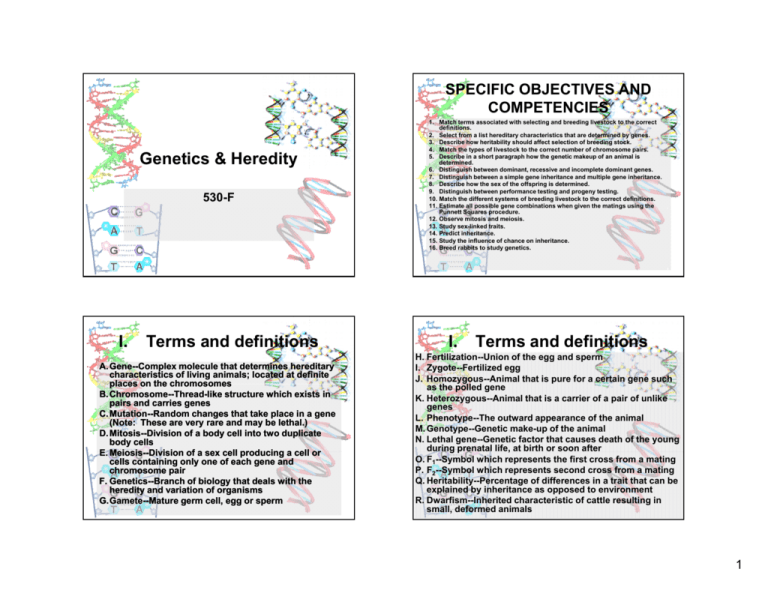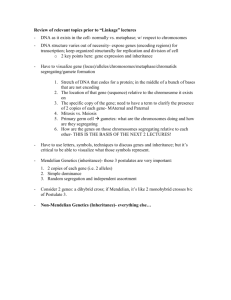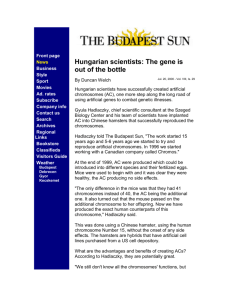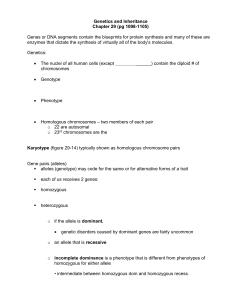Genetics & Heredity I. Terms and definitions I. Terms and definitions
advertisement

SPECIFIC OBJECTIVES AND COMPETENCIES Genetics & Heredity 530-F I. Terms and definitions A. Gene Gene---Complex Complex molecule that determines hereditary characteristics of living animals; located at definite places on the chromosomes B. Chromosome Chromosome---Thread Thread--like structure which exists in pairs and carries genes C. Mutation Mutation---Random Random changes that take place in a gene (Note: These are very rare and may be lethal.) D. Mitosis Mitosis---Division Division of a body cell into two duplicate body cells E Meiosis E. Meiosis---Division Division of a sex cell producing a cell or cells containing only one of each gene and chromosome pair F. Genetics-Genetics--Branch Branch of biology that deals with the heredity and variation of organisms G.Gamete G. Gamete---Mature Mature germ cell, egg or sperm 1. Match terms associated with selecting and breeding livestock to the correct definitions. 2. Select from a list hereditary characteristics that are determined by genes. 3 Describe 3. D ib how h heritability h it bilit should h ld affect ff t selection l ti off breeding b di stock. t k 4. Match the types of livestock to the correct number of chromosome pairs. 5. Describe in a short paragraph how the genetic makeup of an animal is determined. 6. Distinguish between dominant, recessive and incomplete dominant genes. 7. Distinguish between a simple gene inheritance and multiple gene inheritance. 8. Describe how the sex of the offspring is determined. 9. Distinguish between performance testing and progeny testing. 10. Match the different systems of breeding livestock to the correct definitions. 11. Estimate all p possible gene g combinations when given g the matings g using g the Punnett Squares procedure. 12. Observe mitosis and meiosis. 13. Study sex-linked traits. 14. Predict inheritance. 15. Study the influence of chance on inheritance. 16. Breed rabbits to study genetics. I. Terms and definitions H. Fertilization--Union of the egg and sperm I. Zygote--Fertilized egg J. Homozygous--Animal that is pure for a certain gene such as the polled gene K. Heterozygous--Animal that is a carrier of a pair of unlike genes L. Phenotype--The outward appearance of the animal M. Genotype--Genetic make-up of the animal N. Lethal gene--Genetic factor that causes death of the young during g prenatal p life,, at birth or soon after O. F1--Symbol which represents the first cross from a mating P. F2--Symbol which represents second cross from a mating Q. Heritability--Percentage of differences in a trait that can be explained by inheritance as opposed to environment R. Dwarfism--Inherited characteristic of cattle resulting in small, deformed animals 1 II. Some hereditary characteristics determined by genes A. B B. C. D. E. F. Body size C l off hair Color h i coatt Eye color Length of leg Dwarfism Ability to fatten IV. Chromosome pairs of different species A. B B. C. D. E. F. Cattle--30 pairs S i Swine--19 19 pairs i Sheep--27 pairs Chickens--39 pairs Humans--23 pairs Horses--32 pairs III. Heritability Some characteristics in animals are highly heritable while others are not; selection of breeding stock should be weighted towards those factors which have a high heritability – See Hand-out V. Genetic makeup A. Determined by the union of two cells one from each parent cells, B. Each cell contains one chromosome from each pair in the parent or 1/2 the total number of chromosomes 2 Cellular Division-Mitosis Mitosis • Interphase – DNA duplicates • Prophase – Centrioles and spindles establish – DNA condenses to form visible chromosomes (2 chromatids) • Metaphase – Chromosomes align in the middle of the cell • Anaphase – Spindles S i dl attach tt h and d start t t pulling lli the th chromosomes h apartt – Chromatids separate • Telophase – Chromosomes are pulled to opposite ends of cell (poles) • Cytokinesis – Cell divides into two identical cells Cellular Division-Meiosis • Cycle happens twice • Differences – Prophase I • Homologous chromosomes align • Crossing over occurs (4 chromatids) – Anaphase I • Chromosomes divide divide, not chromatids • Second cycle is a reduction cycle but similar to mitosis with no chromosome pairs 3 Meiosis Unique Features of Meiosis VI. Genes Shorthorn Incomplete Dominance A. Dominant--Genes that have the ability to cover up or mask the presence of one member of a set of genes i the in th F1 generation ti Examples: Pure polled; white face in Herefords; drop ears in swine (Note: Dominance is designated by a capital letter.) B. Recessive--Genes that are covered up or masked in the F1 generation Example: Horned; erect ears in swine (Note: Recessive genes are designated by a small letter.) C. Incomplete dominant--Genes that are neither completely dominant nor recessive and which only contribute to a certain characteristic 4 VII. Gene inheritance A. Simple--One pair of genes determines the inheritance of a particular factor B. Multiple--Several pairs of genes determine the inheritance of a particular factor Examples: Genes affecting meat production, milk and butterfat production and growth rate (Note: Growth rate is hard to identify and is controlled by several genes.) VIII. Sex determination A. A female egg contains an X chromosome B B. A male sperm contains either an X or Y chromosome C. Egg and sperm unite randomly to form zygote 1.If egg and sperm contain like chromosomes (X and X), a female is conceived 2.If egg and sperm contain unlike chromosomes (X and Y), a male is conceived 5 IX. Production testing Production testing is the practice of evaluating and selecting animals on the basis of progeny and performance testing. This is done on characteristics of economic importance. A. Performance testing--Practice of evaluating and selecting animals on the basis of their individual merit or performance B. Progeny testing--Practice of selecting animals on the basis of the merit of their progeny (offspring) X. Systems of breeding A. Purebred--Member of a breed; animals which possess a common ancestry and distinctive characteristics and are either ith registered i t d or eligible li ibl ffor registry i t iin th the h herd db book k of that breed B. Inbreeding--System of breeding in which closely related animals are mated Example: Brother x sister, sire x daughter, son x dam C. Out-crossing--Mating of animals that are members of the same breed but which show no relationship close up in the pedigree D. Grading up--System of breeding in which purebred sires of a given pure breed are mated to native or grade females E. Crossbreeding--Mating animals of different breeds XI. Punnett Squares system showing gene combinations A. Cross a pure, polled (PP) bull with horned (pp) cows 1. Mating: PP x pp 2. F1 : Genotype--Pp Phenotype--polled B. Cross F1 males (Pp) with F1 females (Pp) 1 Mating: Pp x Pp 1. 2. F2 Genotypic ratio--1 PP:2Pp:1pp Phenotypic ratio--3 polled: 1 horned 6 2 Gene Crosses ♂ ♀ 7 8








